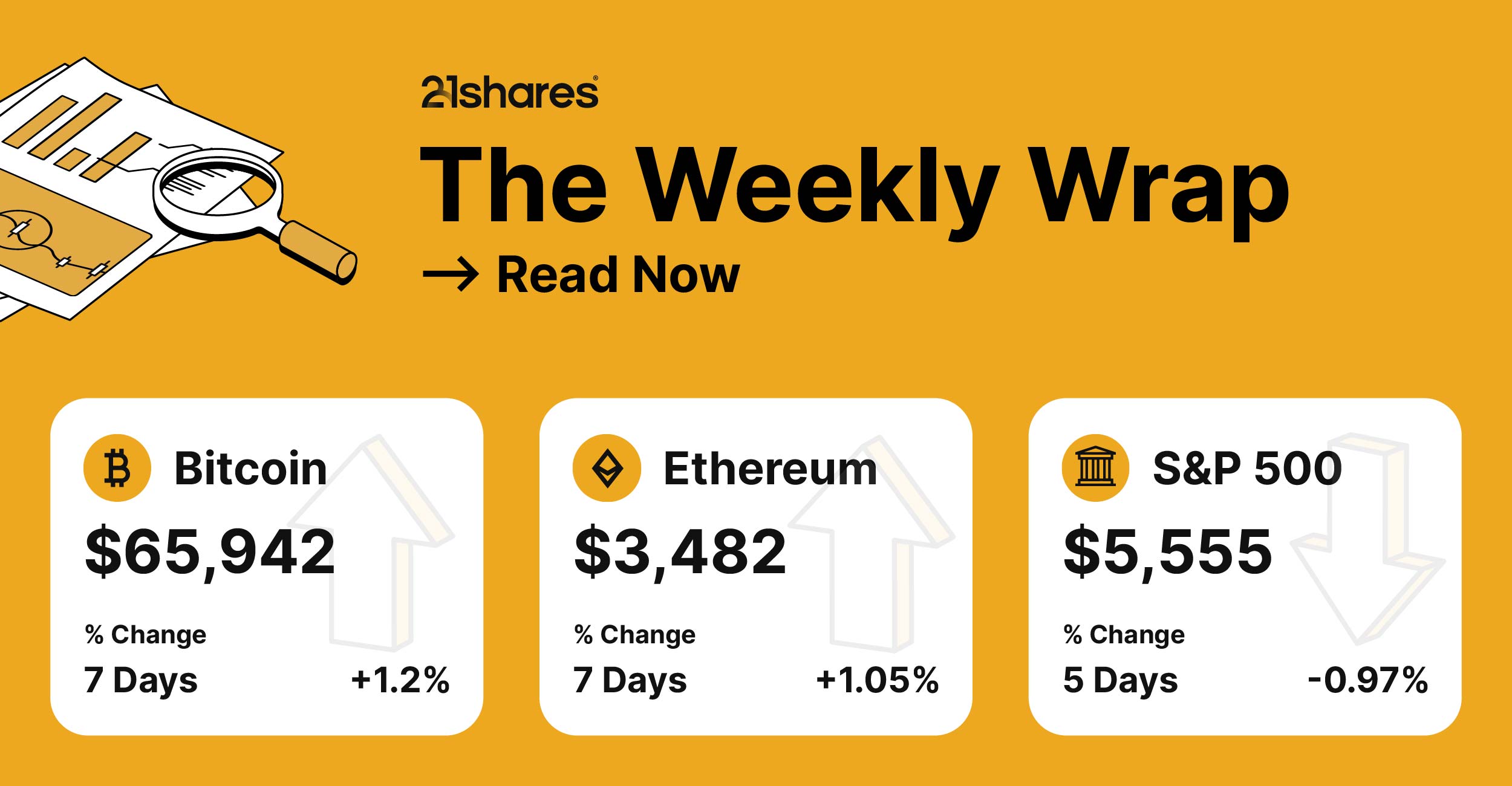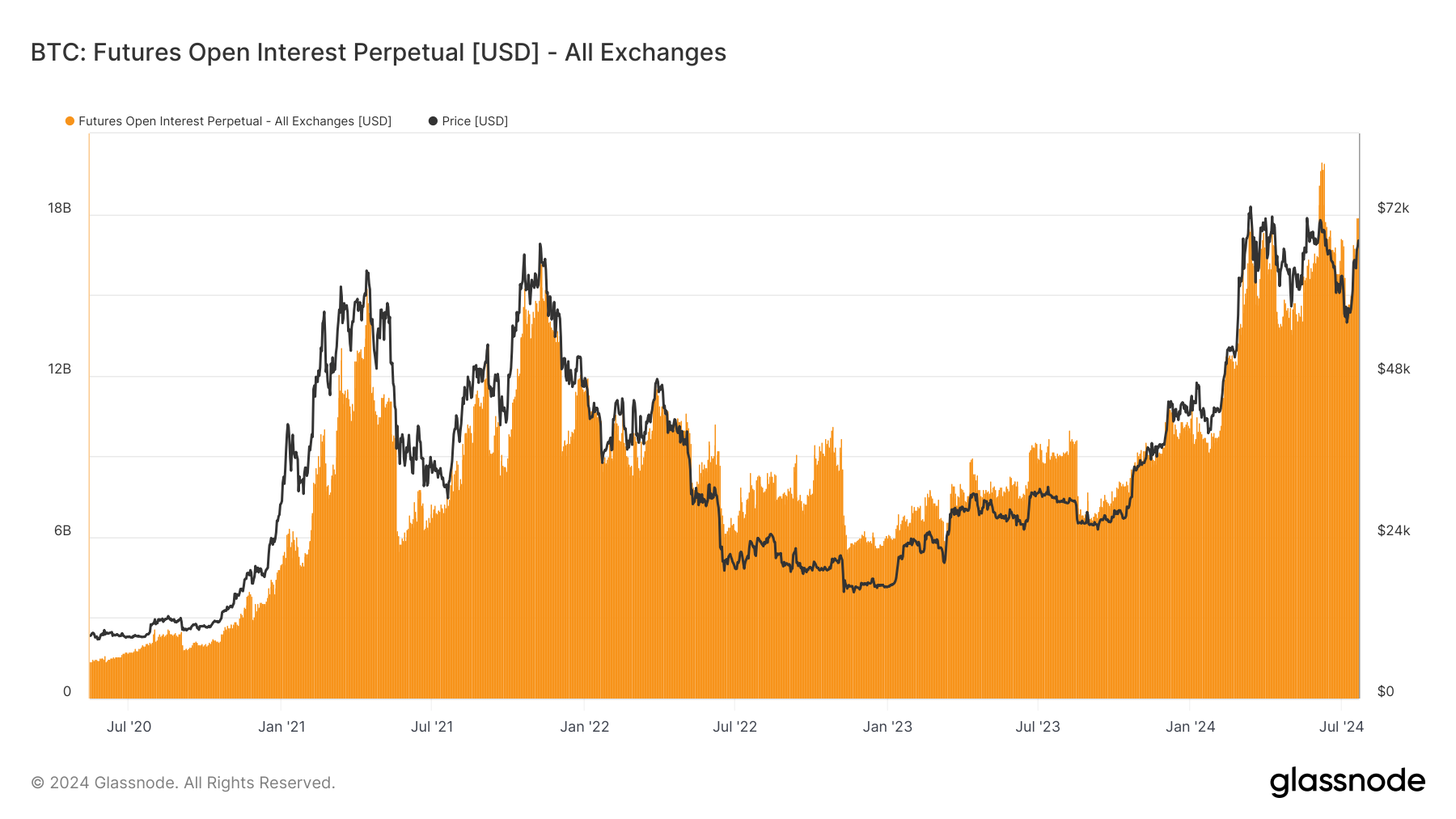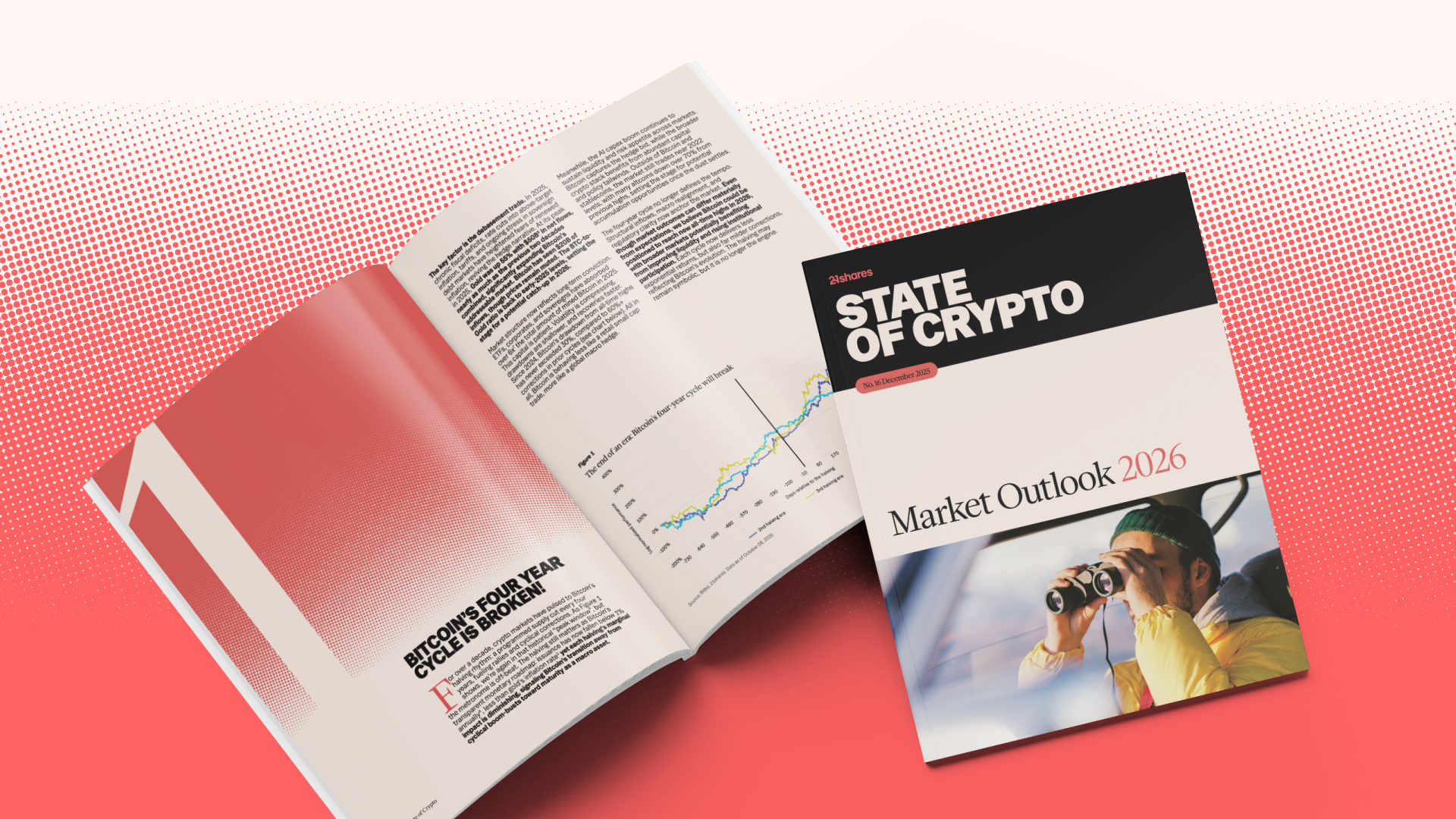US-Wahl sorgt weiter für Aufregung am Kryptomarkt - aber auch Polygon-Upgrade wird mit Spannung erwartet



Diese Woche in Krypto
- Kryptomarkt erholt sich, US-Wahlkampf nimmt Fahrt auf
- Polygon 2.0 zeigt Ausblick auf das „Internet der Blockchains“
Polit-Trubel in den USA – Erholung am Kryptomarkt
Die Inflation in den USA hat sich im Juni abgekühlt: Der monatliche Verbraucherpreisindex (CPI) sank um 0,1 Prozent und die jährliche Inflation lag zuletzt bei 3 Prozent. Daraufhin erklärte der Fed-Vorsitzende Jerome Powell, dass man nicht warten werde, bis die Inflation 2 Prozent erreicht, aber eine weitere Zinssenkung dennoch nicht kurz bevorstehe. Für die Entscheidung zur weiteren Zinssenkung sei hingegen lediglich die sichere Vermutung notwendig, dass die Inflation weiter ansteigen. Das CME FedWatch-Tool zeigt demzufolge eine 90-prozentige Wahrscheinlichkeit für eine Zinssenkung um 25 Basispunkte im September an. In der Zwischenzeit war der Trubel rund um die Präsidentschaftswahlen in den USA der wichtigste Markttreiber und überschattete die Hoffnung auf eine Zinssenkung. Am 21. Juli kündigte der amtierende US-Präsident Joe Biden seinen Rückzug im Rennen um die Präsidentschaft an, was eine moderate Rallye auf dem Kryptomarkt auslöste.
Auf der anderen Seite hat der republikanische Präsidentschaftskandidat Donald Trump mit einer Reihe von Schritten für Aufmerksamkeit gesorgt, die vom Kryptomarkt als positiv angesehen werden. Dazu gehört die kürzliche Ernennung von JD Vance als Vizepräsidentschaftskandidat. Schon 2021, im Rahmen seiner Kandidatur für das Amt des Senators, gab Vance bekannt, dass er Bitcoins im Wert von 100.000 Dollar besitze. Darüber hinaus setzte er sich während seiner Amtszeit als Senator von Ohio für eine Krypto-freundliche Gesetzgebung ein und nahm zeitweise sogar dezentrale Protokolle gegenüber der Securities and Exchanges Commission in Schutz. Nachdem er seine Verbundenheit mit der Krypto-Industrie bekundet und eine Politik zu ihren Gunsten versprochen hat, besteht kein Zweifel, dass die Märkte von den Aussichten einer Präsidentschaft von Trump sehr angetan sind – und der Terminmarkt bestätigt dies. So hat das Open Interest (OI) am Futuresmarkt an den zentralen Börsen in der vergangenen Woche um 19 Prozent zugelegt (siehe Abbildung 1).
Abbildung 1 – Open Interest am BTC Futures Markt

Quelle: Glassnode
Zwischen 14. Und 21. Juli ist das Open Interest (OI) für Future-Optionen um 28 Prozent gestiegen. Offenbar rechnen mehr Händler mit steigenden Preisen, denn das Put/Call-Verhältnis am 21. Juli lag bei 0,45. Optionshändler bereiten sich auf stärkere Marktbewegungen vor, da Trump am 27. Juli, dem letzten Tag der Bitcoin-Konferenz in Nashville eine Rede halten wird. Gerüchten zufolge könnte er ankündigen, Bitcoin während seiner Präsidentschaft als strategische Reserve zu halten. Die Gründe für dieses Vorgehen liegen am Konzept eines fest vorgegebenen Angebots an Bitcoins und auch an der Tatsache, dass die jetzige US-Regierung bereits 0,83 Prozent des zirkulierenden Bitcoin-Angebots hält.
Was können wir diese Woche noch erwarten? Das wichtigste bevorstehende Ereignis ist wohl die Veröffentlichung der Kerndaten zu den persönlichen Konsumausgaben (PCE) der USA am kommenden Freitag. Dies wird von entscheidender Bedeutung sein, da der PCE ein Schlüsselindikator ist, der die Auffassung der Fed über Inflation beeinflusst.
Und schließlich hat die SEC Ethereum-Spot-ETFs für den Handel in den USA zugelassen. Mit mehr als acht regulierten Produkten, die jetzt verfügbar sind, haben Anleger mehr Möglichkeiten, sich am zweitgrößten Kryptoasset nach Marktkapitalisierung zu beteiligen. Diese Zulassung stärkt die Glaubwürdigkeit, die Akzeptanz und das Vertrauen in die Branche der digitalen Vermögenswerte und könnte zu erheblichen Zuflüssen in ETH führen. Diese Zuflüsse werden Erwartungen zufolge nicht mehr als 20 Prozent dessen ausmachen, was BTC-ETFs erreicht haben. Darüber hinaus wird erwartet, dass diese Entwicklung das Interesse an der Anwendungsschicht des Ethereum-Ökosystems ankurbeln wird, die DeFi-Primitive und eine Vielzahl dezentraler Anwendungen umfasst, die die nächste Generation der internetbasierten, erlaubnisfreien Wirtschaft bilden. An ihrem ersten Handelstag verzeichneten die Ethereum-ETFs einen Gesamtwert von 1,1 Milliarden US-Dollar, was fast 20 Prozent des Volumens entspricht, das am ersten Handelstag der BTC-ETFs im Januar (4,4 Milliarden Dollar) verzeichnet wurde.
Wird die Vision des „Internet der Blockchains“ mit dem Polygon-Upgrade 2.0 zur Wirklichkeit?
Das Polygon-Netzwerk, eine sogenannte Layer2-Blockchain, zielt auf die Verbesserung der Leistung und Benutzerfreundlichkeit von Ethereum. Im Rahmen seines neuesten Upgrades leitet die Plattform am 4. September dieses Jahres eine sogenannte „Token-Migration“ ein. Dies bedeutet, dass der ursprüngliche Token MATIC gesperrt und der neue Token POL freigegeben wird. Dieser entscheidende Schritt folgt auf monatelange Diskussionen rund um das Polygon 2.0-Upgrade, das das Netzwerk von einer einfachen Ethereum-Sidechain in ein vielseitiges, interoperables Netzwerk von Skalierungslösungen verwandelt. Es ist wichtig zu wissen, dass das Upgrade die Schaffung eines Ökosystems von miteinander verbundenen Netzwerken ermöglicht, die die sogenannte Zero-Knowledge-Technologie nutzen. Polygon fungiert innerhalb dieses Ökosystems als zentraler Layer (Schicht) und verbindet die Netzwerke miteinander. Zusätzlich beeinhaltet die neue Architektur eine Aggregationsschicht, eine sogenannte „AggLayer“. Diese bietet einheitliche Liquidität für alle Netzwerke, die mit dem „Chain Development Kit“ (CDK), Instrumenten und Ressourcen von Polygon, entwickelt wurden. Lesen Sie unsere frühere Berichterstattung hier, um ein besseres Verständnis von AggLayer zu erhalten.
Zur Vorbereitung des Upgrades bei Polygon kündigte die Stiftung des Netzwerks die Umstellung der Token von MATIC auf POL bereits im vergangenen Oktober an. Der Zeitplan blieb jedoch bis vergangene Woche unklar. Laut der jüngsten Ankündigung ist der 4. September das Zieldatum. Mit dem Upgrade wird POL ähnlich wie ETH zur Gaswährung für die Interaktion mit dem Ökosystem, und darüber hinaus auch zum Staking-Token für die Nutzer, die zur Validierung von Polygon und den damit verbundenen CDK-basierten Blockchains beitragen. Laut dem Plan der Stifung soll MATIC auf Polygon in POL umgewandelt und im Mainnet von Etherum mit MATIC kombiniert werden, der dann ebenfalls in POL umgewandelt wird. Wir erwarten daher einen sprunghaften Anstieg des Gesamtprozentsatzes der konvertierten Tokens, der von den derzeit geschätzten 0,5 Prozent (siehe unten) auf bis zu 50 Prozent nach dem 4. September ansteigen wird.
Abbildung 2 – Der Migrationsprozess bei der Umwandlung von MATIC in POL.

Quelle: 21co auf Dune
In dieser Hinsicht wird POL als “hyperproduktiver” Token dienen, der seine Funktionalität über die Sicherung eines einzelnen Netzes hinaus ausdehnt. Er wird auch als “Re-Staking-Token", der für das erneute Einsetzen bereits auf der Blockchain gesperrter Token dient, fungieren und so die Sicherheit mehrerer Netzwerke validieren. Diese erweiterte Rolle wird es den Inhabern der Token ermöglichen, sich in verschiedenen Funktionen innerhalb des Netzwerks zu engagieren und unterschiedliche Belohnungen in Verbindung mit unterschiedlichen Dienstleistungen zu verdienen. So wird beispielsweise POL eine Schlüsselrolle innerhalb der AggLayer spielen, obwohl die genaue Art der Beteiligung noch nicht feststeht, weil dies von der Abstimmung durch die Community Governance abhängt. In Verbindung mit dem Betrieb des AggLayers können Belohnungen künftig an die Sicherheitsvalidierung aller Netzwerke innerhalb des Polygon Ökosystems gebunden sein.
Hervorzuheben ist jedoch die langfristige Strategie, die mit POL verfolgt wird. Laut Stiftung liegt das Potenzial des Tokens in der Erleichterung der block- und ZK-sicheren Erzeugung und Teilnahme an Datenverfügbarkeitsausschüssen (DAC). Dieser innovative Ansatz könnte als wertvolle Blaupause für andere Skalierungslösungen dienen und unter Beweis stellen, wie man einen größeren Nutzen freisetzen kann. Beispielsweise bei Arbitrum und Optimism; die Token dieser beiden Netzwerke haben aufgrund ihrer hohen Bewertungen eine Kontroverse ausgelöst, zumal sie vor allem in Ihrer Funktion als reine Governance-Tokens eingeschränkt sind. Würden sie jedoch das von Polygon vorgeschlagene Modell übernehmen, könnten beide Netzwerke das Staking ihrer Token im neuen Ökosystem erlauben. Dieser Ansatz könnte eine stärkere Beteiligung der Community an den zentralen Sequenzer-Operationen fördern, da jeder, der seine Token einsetzt, an dem Prozess teilnehmen kann. Dies dezentralisiert nicht nur einen wichtigen Aspekt der Infrastruktur des Netzwerks, sondern mindert auch das Risiko eines einzelnen Ausfallpunkts.
Kalender der nächsten Woche


.jpg)













_logo.svg)
.svg.png)